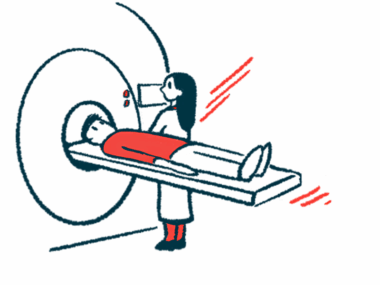Cannabis oral spray nabiximols found to ease spasticity in MS
New analysis shows benefits for patients in 2 clinical trials
Written by |

Treatment with the cannabis oral spray nabiximols helped to relieve spasticity — increased muscle stiffness and spasms common in people with multiple sclerosis (MS) — among participants in two MS clinical trials, according to the results of a new analysis.
“In this analysis, nabiximols was shown to significantly [ease] spasticity across a range of outcome measures that reflect various approaches to the evaluation of spasticity in MS patients,” the researchers wrote.
“The clinically meaningful Spasticity NRS [rating scale] results are accompanied by positive findings for change in spasm count in both [the] GWSP0604 and SAVANT [clinical trials] and improvements in spastic muscle tone in SAVANT,” the team wrote, noting that Spasticity NRS “easily assesses the patients’ own daily experience, which is vital, especially for complex constructs such as spasticity.”
The study, “Efficacy of nabiximols oromucosal spray on spasticity in people with multiple sclerosis: Treatment effects on Spasticity Numeric Rating Scale, muscle spasm count, and spastic muscle tone in two randomized clinical trials,” was published in Multiple Sclerosis and Related Disorders. The work was funded by GW Pharmaceuticals, now part of Jazz Pharmaceuticals, the developer of nabiximols.
Nabiximols approved in some countries but not in US
Spasticity, in which muscles become abnormally tight over time, leading to stiffness and in some cases pain, is a common symptom of MS, affecting most people with the disease. Spasticity can be uncomfortable and make it harder to move around, and studies have suggested that MS patients who experience more spasticity tend to report poorer quality of life.
Nabiximols is approved to treat MS-related spasticity in many countries, including Canada and much of Europe, where Jazz markets the therapy under the brand name Sativex. However, the treatment is not approved for use in the U.S.
The oral spray therapy contains delta-9 tetrahydrocannabinol (THC) and cannabidiol (CBD), the two main biologically active compounds found in the cannabis plant. THC is mainly responsible for the high associated with cannabis use, while CBD is thought to have anti-inflammatory and anxiety-relieving effects on the body.
Several clinical trials have tested nabiximols in people with MS-related spasticity. Here, scientists conducted analyses from two such trials: GWSP0604 (NCT00681538), completed in 2009, and SAVANT (NCT00711646), which concluded in 2004. Most participants in both trials were also taking other anti-spasticity medications in addition to nabiximols.
Both of these studies included a run-in period in which all participants were treated with nabiximols. All self-rated their spasticity on a scale from 0 to 10 on the MS Spasticity Numerical Rating Scale (NRS), in which higher numbers reflect worse spasticity. Patients whose scores improved by at least 20% were deemed responders, and were selected to continue into the main phase of the trial, where participants were randomly assigned to receive nabiximols or a placebo.
The identification of responders to test in the main trial “was done to better reflect clinical use, since patients who do not respond to nabiximols are unlikely to remain on treatment, while those that do respond could experience substantial benefits,” the researchers wrote.
Benefits more pronounced in legs than arms in both trials
This new analysis pooled data from both trials to assess the effect of treatment on patient-reported NRS spasticity scores. It also evaluated patient-reported daily spasm counts and scores on the modified Ashworth scale (MAS), a clinician-assessed measure of spasticity.
In such a post hoc analysis, the review is designed and conducted after the studies are over and all the data are already available. The team noted that they used new statistical techniques to account for missing trial data.
A total of 241 patients entered the placebo-controlled portion of GWSP0604, and 134 entered the main portion of SAVANT. In both studies, most patients had been living with MS for more than a decade, and most were unable to walk short distances without an aid. For almost all patients, the legs were the part of the body most heavily impacted by spasticity.
Analyses of patient-reported spasticity showed that those given nabiximols consistently reported less severe symptoms than those given the placebo over the course of the 12 weeks or about three months of treatment. The average magnitude of the difference ranged over time from 0.52 to 1.96 points on the NRS scale in SAVANT, and from 0.36 to 0.89 in GWSP0604, where patients generally had milder spasticity at the study’s start.
Statistical analyses broadly suggested patients given nabiximols were more likely than those on the placebo to report a substantial improvement, or easing, of spasticity symptoms.
“The findings provide robust evidence of reduction in spasticity attributable to nabiximols,” the researchers wrote.
Analyses of patient-reported spasm counts also showed a consistent effect of nabiximols: Patients given the therapy generally reported fewer daily spasms than those given a placebo. The difference between nabiximols and placebo was generally more dramatic among patients who had been experiencing more frequent spasms before starting on treatment.
“The results of this analysis extend those from the original analysis of both studies, demonstrating that nabiximols led to a sustained treatment effect over 12 weeks on [patient-reported spasticity] scores and average daily muscle spasm counts,” the researchers wrote.
The findings provide robust evidence of reduction in spasticity attributable to nabiximols.
Clinician-rated MAS scores also tended to favor nabiximols over a placebo. However, while the difference between groups was statistically significant in SAVANT, it did not meet that threshold for the GWSP0604 trial. Across both trials, the reduction in MAS scores with nabiximols was generally more pronounced in the legs than the arms.
Safety data from these studies were generally consistent with data from other trials of nabiximols. Common side effects of the cannabis-based therapy include dizziness, sleepiness, and fatigue.
“Overall, the findings detailed in this post hoc analysis demonstrate the positive outcome of using nabiximols compared with placebo in the treatment of spasticity in patients with MS based on well-controlled studies,” the researchers concluded.







